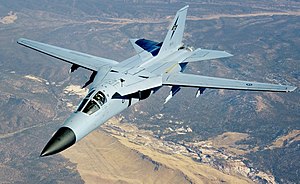General Dynamics F-111C
| F-111C | |
|---|---|
 |
|
| An F-111C of the Royal Australian Air Force in 2006 | |
| Role | Fighter-bomber and reconnaissance aircraft |
| National origin | United States |
| Manufacturer | General Dynamics |
| First flight | July 1968 |
| Introduction | 1973 |
| Retired | December 2010 |
| Status | Retired |
| Primary user | Royal Australian Air Force |
| Number built | 28 |
| Program cost | US$237.75 million (1967) |
| Developed from | General Dynamics F-111 Aardvark |
| Variants | General Dynamics F-111K |
The General Dynamics F-111C (nicknamed "Pig") is a variant of the F-111 Aardvark medium-range interdictor and tactical strike aircraft, developed by General Dynamics to meet Australian requirements. The design was based on the F-111A model but included longer wings and strengthened undercarriage. The Australian government ordered 24 F-111Cs to equip the Royal Australian Air Force (RAAF) in 1963, but the aircraft were not delivered until 1973 because of long-running technical problems. During 1979 and 1980 four of these aircraft were converted to the RF-111C reconnaissance variant. Four ex-United States Air Force (USAF) F-111As were purchased by Australia and converted to F-111C standard in 1982 to replace F-111Cs destroyed during accidents. Australia also operated 15 F-111Gs between 1993 and 2007, mainly for conversion training. The RAAF retired its remaining F-111Cs in December 2010. In Australian military and aviation circles, the F-111 Aardvark was affectionately known as the "Pig", due to its long snout and terrain-following ability.
The F-111Cs gave the RAAF a powerful strike capability but were never used in combat. The aircraft went through modernisation programs in the 1980s and 1990s, and the RAAF acquired improved weapons to maintain their ability to penetrate hostile airspace. Despite this, by the 2000s the F-111Cs were becoming outdated and expensive to maintain, leading to a decision to retire them in 2010 rather than 2020 as originally planned. The F-111s were replaced by 24 Boeing F/A-18F Super Hornets pending delivery of F-35 Lightning IIs in development.
In June 1960, the United States Air Force issued a requirement for an F-105 Thunderchief replacement. The U.S. Navy began a program to develop a new air defence fighter for use on its large aircraft carriers. On 14 February 1961, newly appointed United States Secretary of Defense Robert McNamara formally directed that the services study the development of a single aircraft that would satisfy both requirements. The Tactical Fighter Experimental (TFX) requirements were based largely on the Air Force's needs. A request for proposals (RFP) for the TFX was provided to industry in October 1961. After four rounds of proposals, General Dynamics (GD) was selected over Boeing; GD signed the TFX contract in December 1962.
...
Wikipedia
